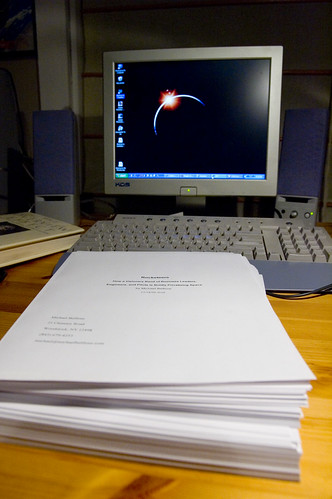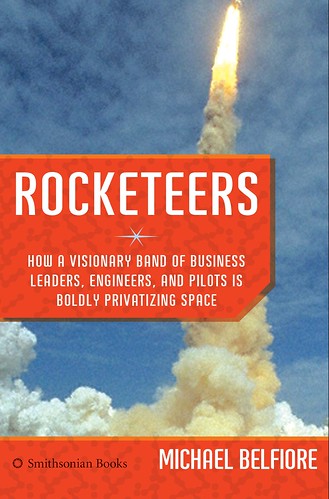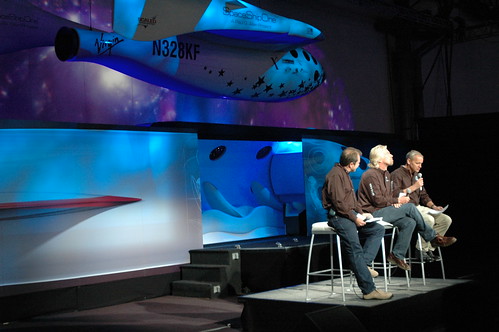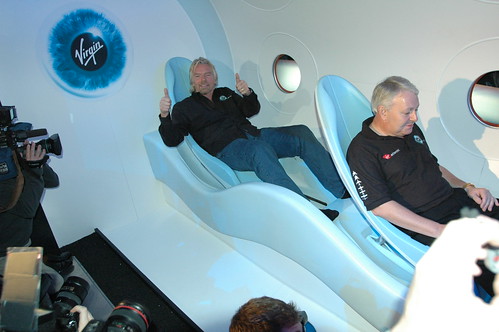I've been gently reminded that I haven't actually revealed much about my forthcoming book,
The Entreprenauts: Visionaries of the New Space Age. Not so terrible, I guess, except that I promised that I would.
I'll give you a rough sketch of it now, fill in more details as my year of writing rolls on. Actually I conceived of this entire blog mainly as a running commentary on the topics covered in the book as I write the book, so stay tuned, please.
First some stats....
Title:
The Entreprenauts: Visionaries and Daredevils of the New Space AgePublisher: Smithsonian Books/Harper Collins
Publication date: Summer 2007
Manuscript due date: Early 2007
I started my professional writing life as a science fiction writer, so my sensibilities lean toward stories that
move, even in nonfiction. I like interesting characters in action. I'm not so crazy about long stretches of exposition, "info dumps," in the parlance of sf writers. Can't really avoid those in nonfiction, of course, but I work to keep those at a minimum, and to use them mainly to advance the story; in this case, the story of commercial spaceflight.
That also means I'm focused exclusively on actual people building actual hardware. I've had my fill of NASA-style viewgraphs and promises that turn out to be empty. This book will tell the story of commercial spaceflight through the words and deeds of engineers, machinists, business leaders, and pilots building and flying real hardware designed to send real people into outer space.
It's a good story, even a great one, on a par with anything from the typewriters of Robert A. Heinlein, Isaac Asimov, Arthur C. Clarke, Ray Bradbury, and all the other sf greats who inspired me to become a writer. I don't pretend to be at the level of those guys at their peak, but I do have a huge advantage over them: I don't have to make anything up. I can pick up the phone or hop on a plane to talk to the characters of my book. The people I'm writing about and the machines they're building are much more exciting than anything I could make up, anyway, because they're
real.
I also believe in the promise of the commercial space age--that is a future powered by cheap solar energy and other resources from space, and the power of personal spaceflight to change life on this planet for the better.
So those are my biases. I'll get those out of way in an extended introduction showing how the events of October 4, 2004, the day the X Prize was won, changed my own life for the better.
Next up, in chapter one, a draft of which I'm finishing now, I'll have a treatment of the founding of the X Prize, background on Peter Diamandis and some of the other founders, and the day in 1994 when Diamandis and Gregg Maryniak took a Cessna 172 up on an aerial tour of Manhattan and started thinking about the early days of aviation and the prizes that laid the foundations of the modern aviation industry.
Next I'll tell the stories of some of the X Prize competitors, including Brian Feeney of the da Vinci Project, with whom I spent a week in 2003. Then I'll move on to the development of SpaceShipOne and Rutan's brainstorm that led to the building of the world's first privately funded spaceship. I plan to devote a chapter each to the two X Prize winning flights. I want to put readers in the cockpit for those flights, to recreate the actual experience that the book is all about. That gets us to the book's mid-point, the core, which is a treatment of the suborbital tourist business SpaceShipOne launched and the people involved in that effort.
The second half of the book will present detailed portraits of many of the other major players in the field--Elon Musk and SpaceX, Robert Bigelow and Bigelow Aerospace, XCOR and the Rocket Racing League.... I can't hit everybody with the kind of detail I want for this book--there's just too much activity in the field at this point, so I'll have to focus on just a few. That's a great problem to have, though, as I'm sure you'll agree.
Finally I'll finish the book with a speculative chapter on what the future might look like 25 years from now, after the industry has found its main markets and has begun to mature. I'm looking forward to really cutting loose in this chapter.
In fact, since it will be the only truly speculative section of the book, I'm considering put it in the form of an annotated science fiction story. What the hell, it's my book, so I can do what I want, right? I have a really cool unpublished piece about a guy whose job it is to repo rockets from businesspeople who can't make their payments. That one might make a good foundation....
 Today I handed in the first draft of Rocketeers, my forthcoming book on commercial spaceflight. All 117,007 words of it, including endnotes. That's 389 manuscript pages, for those of you who don't get paid by the word. Or, probably about 320 pages in the published book.
Today I handed in the first draft of Rocketeers, my forthcoming book on commercial spaceflight. All 117,007 words of it, including endnotes. That's 389 manuscript pages, for those of you who don't get paid by the word. Or, probably about 320 pages in the published book.-749813.jpg)






























